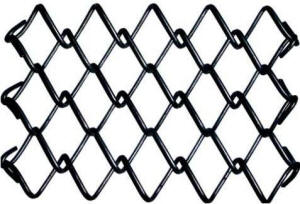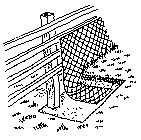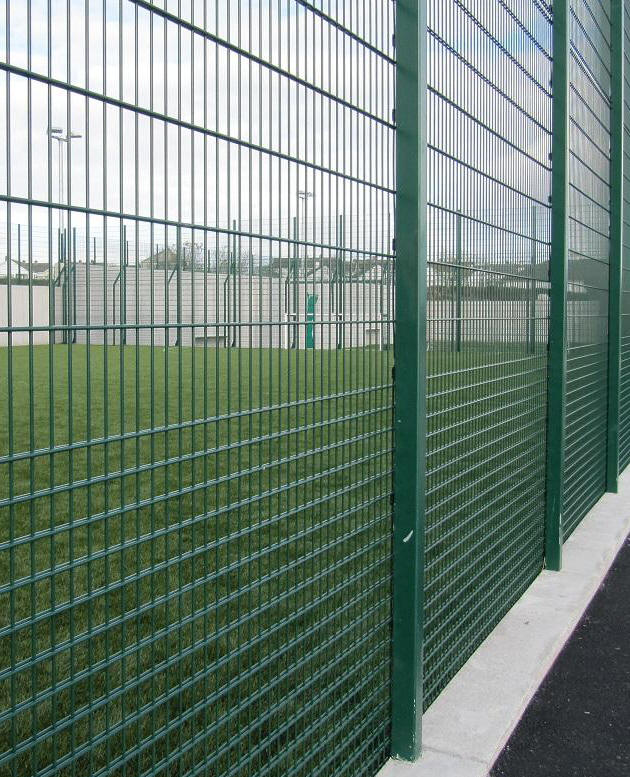Fencing
| RSPB Spotlight on Badgers book |
 |
James
Lowen explores the lives of badgers and their communal
living, feeding habits and threats to their conservation. Click
here to buy:
Paperback edition
Kindle edition
|
One of the biggest "complaints" we get about
badgers is that they are coming into gardens looking for food (or
sometimes just passing through). Apart from toleration, the permanent solution is normally to install
suitable badger-proof fencing.
Electric Fencing
The next solution is to use an appropriate electric fence
to give the badgers a sharp, but non-lethal "sting" on the nose if
they try to get into a protected area. This can provide value-for-money
for ceremonial gardens, putting greens, bowling greens and cricket
pitches; for commercial planting schemes/shared allotments; and for large
gardens. It can be more difficult in the woodland environment; and where
additional wiring loops need to be installed to cope with bumps, ditches
and undulations in the line of the fence.
The electric fence can be bought from specialised farm or
agricultural supplies merchants; and needs to be used between dusk and
dawn for at least a few weeks (i.e. until each visiting badger has had a
"sting" on the nose). The best guesstimate is that they will
remain effective for at least 95% of badgers who have been stung (as
exceedingly few like to receive a second sting). This means that after the initial
few weeks, you can take the risk that the fence can be left in situ, but left
non-electrified; and it may still deter those badgers who have come across
it before.
Electric fences must be powered from a specialised
transformer (which gets its power from the mains or from a car battery).
If you use a car battery, you will need two batteries, so you can charge
one up on a trickle-charger, whilst the other one of electrifying the
fence.
One serious downside of an electric fence, is that they can be
lethal to smaller animals or amphibians. Another is that they need to be
installed on on specialised insulated fence posts above short vegetation
(which can't short out the fence). In the summer months, vegetation can
grow very quickly, and this can soon "short out" the electrified
cables.
There are also potential liability issues.
Whilst the fences are non-lethal for humans, you do need to maintain
suitable warning notices at frequent intervals along the electric fence to
warn people the fence will give them a painful shock. As society seems to
becoming ever more litigious, the possibility of having to defend yourself
in court over the
use of a non-lethal electric fence can not now be ruled out with 100%
certainty. For an example of the illegal use of an electric fence, please
see the following news article: 22 May 2003
from BBC News.
If you are interested in using electric fencing to deter
badgers, we would very very strongly recommend that you seek advice from either
a Badger Consultant or a
local Badger Group
who have experience of setting up and maintaining them. The
"standard" sort of electric fence (normally just one-wire) used
for cattle is NOT suitable for badgers.
To stop badgers getting in to your vegetable patch, use
electrified flexinet fencing (pegged down along its length to prevent
badgers squeezing underneath) or two strands of electrified Polywire at
7.5-20cm above ground.
Wire Fencing
 If you wish to install permanent fencing
this is a substantial operation, as you need exceptionally strong wire
fencing, which needs to be sunk underground between 30cm and 50cm deep.
You also need to be sure that all access and exit points are
badger-proofed - which can mean installing automatic gate closers where
you have absent minded children or visitors. Unless you have an
exceptionally large or valuable private garden or do commercial planting,
this enormous can rarely be justified; except in new-build or major
re-build schemes. If you wish to install permanent fencing
this is a substantial operation, as you need exceptionally strong wire
fencing, which needs to be sunk underground between 30cm and 50cm deep.
You also need to be sure that all access and exit points are
badger-proofed - which can mean installing automatic gate closers where
you have absent minded children or visitors. Unless you have an
exceptionally large or valuable private garden or do commercial planting,
this enormous can rarely be justified; except in new-build or major
re-build schemes.
Badger-proof fencing is required for all sorts of
reasons. Such fencing may be needed for the badgers own protection - for
example, to keep them away from busy roads, motorways and railway lines.
If their territorial boundary is aligned with the road or the railway
line, the fence would be used to stop any inquisitive badgers from
exploring. If their territory was on either side of the road or railway,
the fencing would be used to direct the badgers to a safe crossing point -
such as a culvert, tunnel or bridge.
Fencing may also be used to exclude badgers from getting
into an area where they might pose a danger to themselves or, by breaking
down a less resilient fence, thereby allow children to access a dangerous
area; so such fencing may be used around electrical supply installations,
chemical processing or storage facilities and, of course, military
installations.
Badger-proof Fencing?
|
Despite the claims made by various manufacturers,
very few fences can be certain to be 100% badger-proof; and badger-resistant is
perhaps a more accurate description of what the fence usually provides.
The real-world effectiveness of the fence will depend on
how determined the badgers are to break through or otherwise circumvent
the fence; as well as how opportunistic they might be in a particular
circumstance; and how well the fence has been installed. |

Click picture to
see a larger picture
|
Individual
badgers may be very determined to climb the fence; and a particularly
skilful
individual animal may be able to climb several feet up a wire fence and
make an ungainly drop over the other side. Others may adopt a team-based
approach, where they make great efforts to gnaw and scratch at support
posts, or joins in the wires; or even excavate tunnels deep underneath the
fence. On other occasions, gaps in the fencing, perhaps due to accidents
or vandalism; or poor installation; or gates being left open, may be
exploited by badgers and other species. This does not happen very often,
but it would be very wise to allow at least a small amount in the total
fencing budget for a detailed inspection a few days and a few weeks after
the fence has gone up, to see if it has any vulnerable areas.
One of the fencing types used in the past has been
plastic-coated chain-link fencing (2.5mm wire) or galvanised heavyweight
animal fencing. This needs to be at least 120cm tall; and ideally made
from a single "strip". Using a two-strip approach is possible,
but it is extremely difficult to make the joins sufficiently badger-proof
- especially as they may well be at a height at which the badger can exert
maximum power from their claws. Poor fencing practices are an especial
risk if contractors have agreed to do the fence for a fixed price; and
sections of the fence might later prove difficult or troublesome to
inspect.
To be effective, the fencing needs to be sunk into the
ground to a depth of 50cm AND so that there is a right angle bend in the
direction away from the road/railway. This may prove exceptionally
difficult or expensive to do for existing roads; although it may prove
most cost-effective for new-build roads given the amount of construction
and excavation work already to be done.
In areas which have large numbers of hard rocks, it may
be possible to pin the fencing to the rocks, instead of blasting through
them. Also, in areas where badgers have very rarely or never been seen,
road companies may opt to install as little as 30cm underground, with no
right angle bend. This may be enough to prevent the occasional badger
visitor from starting a dig. However, in the areas around setts, badger
paths and crossing points the fence should be buried to the full 50cm
depth with the right-angle bend.
 An alternative
to the fitting an underground fence is to
install a concrete barrier instead. Again this needs to be 50cm deep; and
it needs to provide a dig-proof and scratch-resistant surface. We have
seen this done by digging a narrow trench; filling the base with
high-strength cement, and setting concrete paving stones vertically on
their edges. Once set, the trench can then be re-filled with the excavated
soil. Small gaps can be left between the paving stones to help with
drainage and to buy fewer paving stones overall. The top edge of the slabs
should then be capped with another resilient concreted-in layer, such as
concrete coping stones. These coping stones can then be used as an anchor
to support a wire fence. As the wire fence may have some flexibility at
ground level. it's base needs to be securely fastened to the concrete
bases at very frequent intervals. This is used around some housing
estates, although the perimeter of the estate may in fact have a twin
fence. The other fence would be the badger-proof wire one; and the inner
fence a taller wooden one to provide the new human residents privacy from
roads, each other and anything else they don't want to look at. An alternative
to the fitting an underground fence is to
install a concrete barrier instead. Again this needs to be 50cm deep; and
it needs to provide a dig-proof and scratch-resistant surface. We have
seen this done by digging a narrow trench; filling the base with
high-strength cement, and setting concrete paving stones vertically on
their edges. Once set, the trench can then be re-filled with the excavated
soil. Small gaps can be left between the paving stones to help with
drainage and to buy fewer paving stones overall. The top edge of the slabs
should then be capped with another resilient concreted-in layer, such as
concrete coping stones. These coping stones can then be used as an anchor
to support a wire fence. As the wire fence may have some flexibility at
ground level. it's base needs to be securely fastened to the concrete
bases at very frequent intervals. This is used around some housing
estates, although the perimeter of the estate may in fact have a twin
fence. The other fence would be the badger-proof wire one; and the inner
fence a taller wooden one to provide the new human residents privacy from
roads, each other and anything else they don't want to look at.
The other big issue with fencing is that of ground
conditions. We have already mentioned the risks of land drainage being
affected, but fences will be expected to be snug across the ground -
including over bumps, and down into troughs, dips and drainage ditches. We
would reiterate the point that a determined badger will be able to get
through a small gap; and it may appear hell-bent on enlarging any existing
gap which is too small. Checking the fencing in the early days will allow
any gaps or weaknesses to be rectified - hopefully before an incident or
an accident occurs.
In terms of locating fences, badgers are generally quite
shy creatures, and many may seek the cover of walking along hedgerows,
walls and fences to try and remain unseen. Accordingly, installing fencing
along existing boundaries may be the better option.
A major reason for installing badger-proof fencing is to
direct badgers towards safe crossing points (such as wildlife tunnels or
bridges). Given the costs involved in doing the fencing; it really does
pay to make sure a badger expert is involved.

| About Wildlife Consultants |
| Laws protect badgers from being
harmed and their homes damaged. Whilst permits can be issued to allow such badgers to be moved, you
need to have professional
research done to see where the badgers are and what they need. In
commercial property development, finance and logistics can be very
important. Also, if an insurance company is paying for
re-building work, they may want to be certain
that the commercial risks are understood too. Wildlife Consultants are
usually highly experienced at dealing with such legal and commercial
issues and should be able to help mitigate the risks. Wildlife consultants help deal with protected species,
making sure that developers understand the law AND the needs of any
animals. Local Badger Groups
may also conduct badger surveys, and we run our own email-based
Ask An Expert service. |
|
